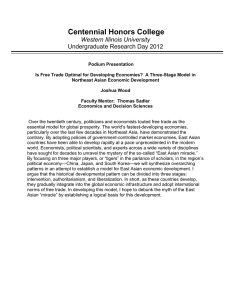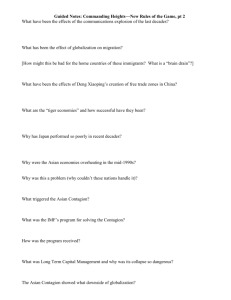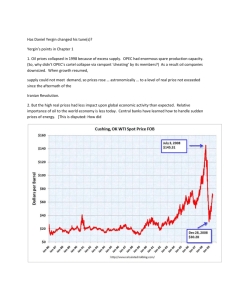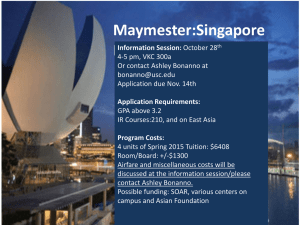Tell me the truth about Thailand*
advertisement
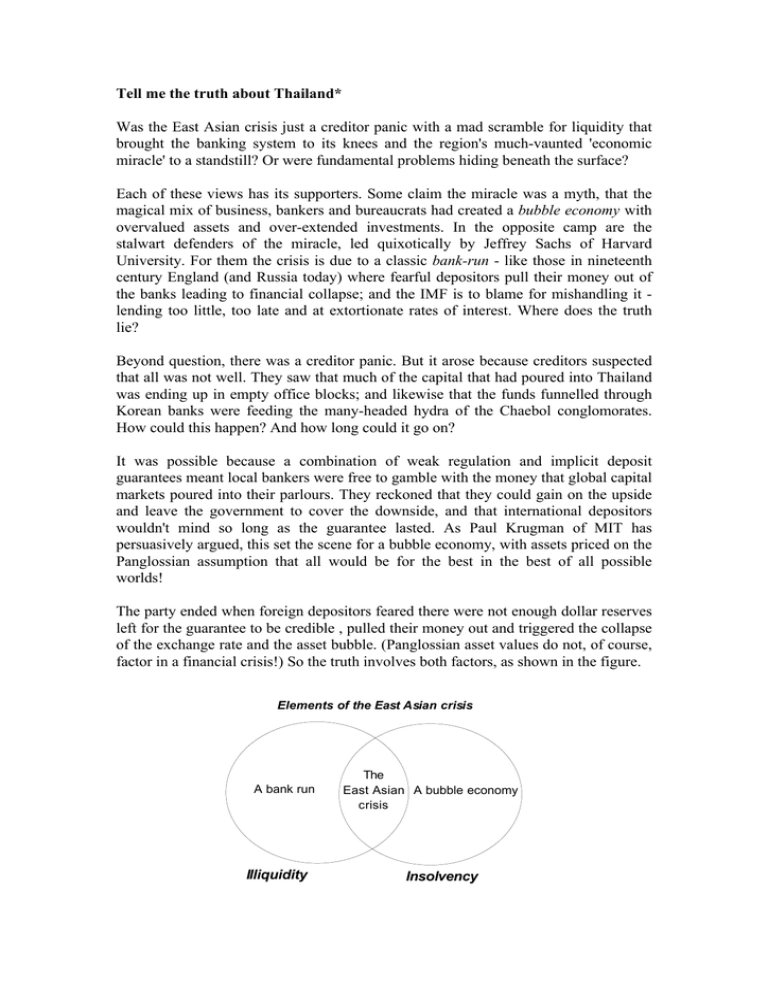
Tell me the truth about Thailand* Was the East Asian crisis just a creditor panic with a mad scramble for liquidity that brought the banking system to its knees and the region's much-vaunted 'economic miracle' to a standstill? Or were fundamental problems hiding beneath the surface? Each of these views has its supporters. Some claim the miracle was a myth, that the magical mix of business, bankers and bureaucrats had created a bubble economy with overvalued assets and over-extended investments. In the opposite camp are the stalwart defenders of the miracle, led quixotically by Jeffrey Sachs of Harvard University. For them the crisis is due to a classic bank-run - like those in nineteenth century England (and Russia today) where fearful depositors pull their money out of the banks leading to financial collapse; and the IMF is to blame for mishandling it lending too little, too late and at extortionate rates of interest. Where does the truth lie? Beyond question, there was a creditor panic. But it arose because creditors suspected that all was not well. They saw that much of the capital that had poured into Thailand was ending up in empty office blocks; and likewise that the funds funnelled through Korean banks were feeding the many-headed hydra of the Chaebol conglomorates. How could this happen? And how long could it go on? It was possible because a combination of weak regulation and implicit deposit guarantees meant local bankers were free to gamble with the money that global capital markets poured into their parlours. They reckoned that they could gain on the upside and leave the government to cover the downside, and that international depositors wouldn't mind so long as the guarantee lasted. As Paul Krugman of MIT has persuasively argued, this set the scene for a bubble economy, with assets priced on the Panglossian assumption that all would be for the best in the best of all possible worlds! The party ended when foreign depositors feared there were not enough dollar reserves left for the guarantee to be credible , pulled their money out and triggered the collapse of the exchange rate and the asset bubble. (Panglossian asset values do not, of course, factor in a financial crisis!) So the truth involves both factors, as shown in the figure. Elements of the East Asian crisis A bank run Illiquidity The East Asian A bubble economy crisis Insolvency The bursting bubble - leading to widespread insolvency - is on the right; and the bankrun version of events - creditor panic leads to financial collapse - is on the left. The truth lies where the two circles overlap: there certainly had been panic but it has been triggered by genuine problems of over-investment and overvaluation in emerging East Asian economies. This combination helps to explain why the IMF was unwilling simply to throw money at the problem: theirs was the unwillingness of would-be rescuers to get themselves drowned! Granted, there were flaws in the East Asian fundamentals. But no country is perfect and the punishment meted out to these emerging markets by global capital markets is out of all proportion - whether measured by the collapse in their currencies and stock markets or by the fierce contraction in output. They have been taught a bitter lesson. But what of global capital markets that helped to create the bubble and triggered the collapse? Are there steps to be taken right away to help sort things out? Are there reforms to the international monetary system that might help prevent a repeat performance? Here are some practical suggestions, beginning with the immediate steps: • For the key members of the IMF to provide the extra funding already requested for it to act as ‘lender of last resort’. (This means the US Congress must stop dragging its feet!) • For the Asian central banks to quantify the losses resulting from deposit insurance and to devise appropriate packages for financial reconstruction (as Thailand has recently done). This will involve bank mergers, closures and bail-outs and will not be cheap (as Japan is discovering). • For international creditors and debtors to get together to negotiate the roll-over of some short-term debts (in Korea, for example) and the write-down of other debt that is simply beyond the capacity to pay (in Indonesia, for example). To bring creditors to negotiating table, debtors might consider a unilateral stay of payments - backed by continued lending by international financial institutions, subject to appropriate conditionality. • To create a surveillance mechanism to oversee domestic financial regulations and supervision and the international involvement of highly-levered investment funds; this will involve the IMF, the World Bank and the countries of the region. • To request the surveillance unit (or other appropriate body) to devise capital inflow controls (and higher margin requirements on levered lenders) so as to reduce financial vulnerability of emerging market economies. • To create a regional Bank of International Settlements - an Asian BIS - to help reduce ‘contagion’ by providing short-term credits. • To convene a new Working Party of the G10 to recommend changes in the Articles of the IMF enabling it to help resolve liquidity crises by debt roll-overs and workouts, i.e., to act as a kind of bankruptcy court. • To delay writing the requirement of capital account liberalisation into the Articles of the IMF until it is safe to do so; i.e., sufficient progress has been made on the foregoing action points. Lastly, be warned: if nothing is done, another crisis will soon be showing in a country near you! Marcus Miller Department of Economics and Centre for Globalisation University of Warwick Coventry CV4 7AL UK T: +44 (0)1203 523048 F: +44 (0)1203 523032 e-mail: marcus.miller@warwick.ac.uk * This is a revised version of the piece appearing in Insights no.26, IDS, Sussex. It draws on “Financial crisis in East Asia: bank runs, asset bubbles and antidotes”, a paper jointly written with Pongsak Luangaram for the Clare group, published in the July 1998 issue of the National Institute Economic Review.

